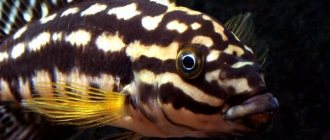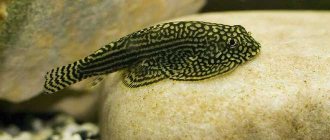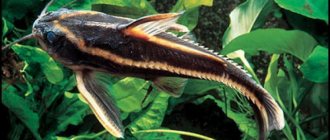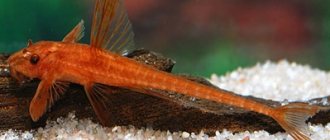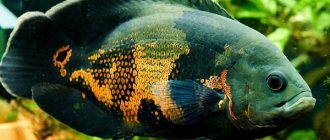5
(2)
This amazing fish attracts the attention of aquarists in many countries. Its unusual body structure, interesting habits and the ability, in natural conditions, at night, to move over land from one body of water to the next, set it apart from other representatives of the aquatic world. Meet the sacbranch catfish - a voracious, mustachioed demon with a poisonous spine.
Description
The sacbranch catfish is difficult to confuse with other inhabitants of the aquarium. Its unique body structure and thick mustache definitely make it stand out from other fish.
External characteristics
The body of the catfish is elongated and flattened on the sides. In nature, its length can reach 60–70 cm, but in an aquarium the fish rarely grows even up to 30 cm. The head is small and flat. There are 4 pairs of whiskers located near the mouth - above and below the jaw, as well as near the nose. With their help, the catfish orients itself in space and “feels” objects around it. The eyes are small and deep-set, often yellow or blue.
The pelvic fin starts from the middle of the body and ends at the tail. It is a combination of 70 rays. The caudal fin has the shape of a trapezoid. The lateral fins are located symmetrically to each other and consist of 10 rays.
Color
The color of the sacbranch catfish varies from dark blue to brown or black. But sometimes you can find albino fish, whose bodies are painted white or milky.
Habitat in nature
It occurs quite often in nature, distributed in India, Bangladesh, Pakistan, Nepal, Sri Lanka, Thailand, Myanmar and Bhutan. H. fossilis is found in places with weak currents, often in stagnant water with excess oxygen - swamps, ditches and ponds, but is sometimes found in muddy rivers. It can go into large rivers and has even been seen in salt waters.
It breeds in waters during the monsoon months, in abandoned ponds and ditches, when sufficient rainwater accumulates. It is in great demand due to its nutritional value.
Physiological features
The sacbranch catfish got its name due to the unique structure of its lungs. These internal organs in fish are two oblong sacs that stretch across the entire body from head to tail. Due to the large volume of their lungs, animals can go without water for several hours.
Another distinctive, but more dangerous feature is the spikes located near the chest. Their sacs contain poison. It is not fatal to humans, but in isolated cases it can cause anaphylactic shock. If poison gets in, you should rinse the affected area under hot water and consult a doctor.
Lifespan
The average lifespan of these fish varies from 5 to 10 years, depending on the conditions of detention.
Home arrangement for the sacbranch catfish and maintenance rules
When planning to buy a sacbranch catfish, find out in advance about the rules for keeping it. The size of the aquarium should be 100-250 liters. The size of the pet depends on its parameters. The price of the sacbranch catfish attracts any aquarist with its affordability.
Depending on the size, it can range from 500 to 2500 thousand rubles. There should be a lot of hiding places at the bottom of the new home. These could be: driftwood, caves, clay pots with a side hole, ceramic pipes or abundant algae.
The main thing is that, in addition to shelters, there is a place for free swimming, since catfish lead an active lifestyle at night. Therefore, it is desirable for the lighting in the aquarium to be dim. Make sure that there are no sharp edges in the artificial pond.
Sac-branch catfish have delicate skin and can be easily injured. Make sure that the lid of the aquarium is closed, as at the first opportunity the catfish can get out. A small hole is enough for him to go in search of new bodies of water.
In their natural environment, this ability helped them find new habitats in dry places. This fish still has survival instincts. As already mentioned, aquarium sacbranch catfish lead a very active lifestyle and, naturally, leave behind a lot of waste.
It is important not to forget about systematic water changes and strong filtration in the aquarium. Replacement should be carried out several times a week, and it should be no more than 10-15% of the total volume in the “glass apartment”. The most suitable water parameters for catfish to live in should be pH – 6.0-8.0, temperature 21-25°C.
Reproduction of sacbranch catfish in captivity is most often successful. To do this, you just need to create the necessary conditions. To begin, place the couple in a separate aquarium, at least 100 liters in size. The bottom should be sandy. Make sure that the “room for the young” has all kinds of shelters and algae. That's all, nature must take its course.
Sacbranch catfish have their own diseases, like any living organism. One such case is swim bladder disease. The reason for its occurrence is the oversaturation of water with oxygen.
Symptoms to look out for: tilted body position and upper bend in the tail area, bulging eyes, blisters on the fins or other parts of the body. Be attentive to your pet's physical condition and behavior. This is extremely important.
Content
The sacbranch catfish is unpretentious and easily adapts to many conditions. But to make the fish’s life comfortable, you need to follow several recommendations.
Requirements for an aquarium
To keep this fish, you need to choose a tank with a volume of 100 liters or more to ensure its full growth and comfortable living conditions. Also, the aquarium should have a lid, because catfish love to jump out of the pond.
Water parameters
For comfortable keeping of the sacbranch catfish, you need to set the following water parameters:
- Temperature – 25 – 27°C;
- Acidity – 6.5 – 7.3 pH;
- Hardness – 10 – 14°.
Changing water
Despite their natural habitat conditions, where fish spend most of their time in stagnant water, aquarium specimens are more demanding about the cleanliness of the environment. You need to change the water every week, updating it by 30%.
Lighting
The saccabranchial catfish is a nocturnal predator whose peak activity occurs at night. Therefore, the lighting in the pond should be dimmed, diffused and the length of daylight should be reduced. It is not recommended to place the aquarium near a window. It is better to use special fluorescent lamps with cold light.
Filtration and aeration
It is advisable to choose low or medium filter power to simulate the natural habitat of fish. But due to the fact that catfish produce a large amount of waste products into the water, strong aeration must be established.
Scenery
The main rule when choosing decorations for an aquarium with sacbranch catfish is the absence of sharp corners on objects that can injure delicate skin. But there should be a lot of decorative items so that the catfish can hide there and rest during daylight hours. You should choose:
- driftwood;
- Grottach;
- Gorges;
- Stones;
- Caves.
Priming
It is better to choose small pebbles or gravel as soil. Such a base will not impede the movement of the fish along the bottom and will make its appearance more expressive.
Natural habitat
In the wild, the sacbranch catfish lives throughout almost all of Southeast Asia. It is found in Sri Lanka, eastern India, in the reservoirs of Pakistan, Laos, Vietnam, and Myanmar. As a rule, in slow-flowing rivers with low oxygen content. Actually, additional respiratory organs have developed in order to adapt to natural conditions.
As a rule, fish stay near the bottom and sometimes float to the surface to get a portion of air. If the catfish is deprived of this opportunity, it will quickly die. If the reservoir dries up, the fish will be able to stay on land for several hours, during which time it will move to more suitable conditions.
Note ! Locals are not very fond of the Sacbranch catfish due to its poisonous spines. If it gets caught in a net, it is usually cut out along with part of the net to avoid direct contact.
Video – Sacbranch catfish
Feeding
The diet of pouchbranch catfish should be balanced and varied. The majority of the diet should be animal feed containing protein. For example:
- Tubifex;
- Bloodworm;
- Shrimps;
- Worms;
- Minced fish;
- Squid.
Catfish cannot tolerate plants on the menu, I refuse every such dish.
It is also not prohibited to feed fish with industrial food designed specifically for their species. It is important to remember that you need to purchase such products only in special pet stores.
Choice of neighbors
If you want to add neighbors to your catfish, then you should choose them based on their size and temperament. Sac-branch catfish are extremely voracious; they are capable of mowing down all the small inhabitants in one night, so you should not add miniature fish to them.
It is better to pay attention to large breeds with a predatory character, such as:
- Astronotuses;
- Cyprinidae;
- Cichlids;
- other large aquarium catfish.
Cichlids are suitable aquarium neighbors for sacbranch catfish.
Perhaps you should not keep them together with only the red-tailed catfish; this inhabitant of aquariums can eat almost anyone. And it grows faster than the sacbranch. In any case, there will be constant conflicts and serious night battles between this couple. Therefore, for the sake of peace of mind of household members, they should not be kept together.
The sacbranch catfish will decorate the aquarium for those who are fascinated by the inhabitants of the bottom. He is large, beautiful in his own way, and interesting to watch during periods of his activity. The maintenance is not very difficult even for beginners, but in this case it is better to keep one or a couple of them.
https://youtube.com/watch?v=GstPlszpDZ4
Compatibility with other fish
Very often, the sacbranch catfish is mistaken for a peace-loving and calm fish. However, their predatory nature suggests otherwise. Common neighbors for this fish are large calm cichlids, similar in size or even larger than it.
In addition to cichlids, sacbranch catfish neutrally calmly share territory with such fish as:
- Gourami;
- Large barbs;
- Labeo;
- Catfish;
- Rainbows;
- Knife fish.
Who do sacbranch catfish live with?
The sacbranch catfish, despite the assurances of some sellers, is not a harmless fish. It is 100% carnivorous and is not suitable for keeping in community aquariums. By placing it in a tank where schools of small fish - swordtails, neons, guppies - are frolicking, you may soon not find them in your home.
This inhabitant can live only with those fish that are too large to be included in its diet. Most often, large cichlids keep the company of pouchbranch catfish, but they can also get along well with the following neighbors:
- scalars;
- Mastacembel of Thailand;
- labeo;
- large catfish;
- iris;
- knife fish;
- gourami;
- polypterus;
- large barbs.
The sacbranchial dream is an interesting, peculiar inhabitant that can cause ambivalent feelings. Its toxicity and distinctive appearance may confuse you, but experienced aquarists who managed to find a “common language” with this inhabitant managed to appreciate its positive qualities.
Breeding and reproduction
Fish reach sexual maturity at the age of two years. Readiness for spawning can be recognized by the appearance of spots on the entire body of the catfish. The finished fish are placed in a separate tank with a large number of plants and shelters. The water temperature in the spawning area is raised to 30°C.
Then the female begins to lay eggs in portions (up to 400 eggs at a time), and the male then fertilizes her. After this, the parents are returned to the aquarium, and the water in the spawning area is completely replaced. After 3-4 days the fry appear.
Aquarium fish: how to make the right choice
People who decide to have aquarium fish are faced with a rather difficult question - what kind of pet to choose. If you search well, you will find that you will have to choose from almost 2,000 species of a wide variety of freshwater fish. On this page we tried to collect all the necessary information about the aquarium fish - the sacbranch catfish. If you have never had an aquarium before, you don’t need to choose based on the principle of a beautiful fish and an ugly fish. It is necessary to take into account a lot of variables: what kind of food it prefers, the temperature and composition of the water, whether it is a predator or not, whether it is dangerous for humans, whether it gets along with other species, and many other interesting things. If we classify conditionally, we can distinguish two large groups of fish:
- Easy-to-care fish, not at all demanding of environmental conditions, can survive even in unfavorable situations. They have high endurance by nature, because they live in places where water constantly changes its characteristics or even disappears for a while. However, for health and beautiful appearance, such fish need to be provided with conditions as similar as possible to their natural habitat.
- Difficult to care for fish, most of them belong to tropical latitudes. For them, you need to create special conditions in the aquarium, again as similar as possible to the area where they live in nature. These species rarely breed in captivity, so they are brought from the wild.
For a novice fish breeder, it is better to choose one of the most unpretentious species. In addition to the prospect of not being able to cope with caring for a “capricious” fish, there is a danger of introducing an exotic disease that can harm the rest of the flora and fauna of the aquarium. If you like the aquarium fish, the sacbranch catfish, carefully read the characteristics, character, feeding, care and breeding of these fish.
Diseases and their prevention
Sacbranch catfish are prone to esophageal diseases and progression of ulcers. If the fish is poisoned, it is recommended to deprive it of food for a day, and then increase the amount of protein in the diet.
Ichthyophthyriosis (or semolina) is also a dangerous disease for these catfish. It should be treated by quarantine and baths using green malachite.
In addition to common diseases of aquarium fish, sacbranch catfish most often suffer from skin lesions, which are easily injured due to the lack of scales. Scratches and wounds should be treated with conditioners (iodinol, melafik, pemafik, etc.).
The sacbranch catfish certainly attracts attention not only with its appearance, but also with its mysterious danger. Keeping such a capricious fish is not easy. But with patience, attention and effort, you can tame this black demon.
Nutrition and lifespan
According to reviews from avid aquarists, the sacbranch catfish loves to eat hearty and tasty. He is omnivorous. Its diet consists mainly of animal food. Worms separately and mixed with dry food, shrimp, fish fillets - the catfish will not refuse these dishes. It feeds both at the bottom and while floating up. Do not overfeed this “glutton”. It swallows food completely, so it is very important for the health of the fish that the pieces are not large.
Once a week, spend fasting days for him. The fry should be fed with brine shrimp. How long the sacbranch catfish lives depends on care and living conditions. The lifespan is a minimum of 8 - a maximum of 20 years.
What are your food preferences?
It will not be a surprise to anyone to learn that such a catfish eats food of animal origin, not disdaining other smaller fish and their young.
Leading a nocturnal lifestyle, it ambushes its prey and eats everything that can fit in it.
He also does not refuse dry artificial food. It will appreciate chopped worms, minced meat or fish, and chopped shrimp. He eats a lot and often, which is why he grows. The larger the volume of the aquarium where such a resident lives, the larger the individual grows.
It will not eat plants, although their presence in the aquarium is mandatory. He uses them to hunt or hide from bright light.
